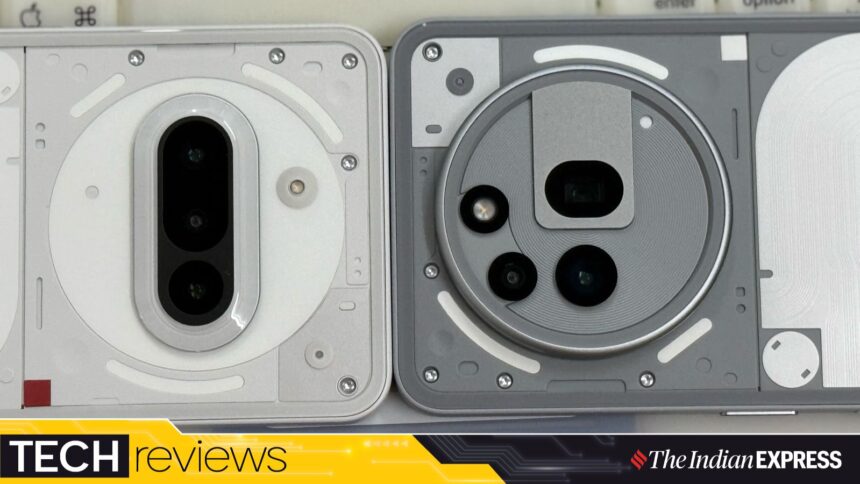When I first heard Nothing was coming up with the new Phone 3A series, I thought they would move on from cool designs and follow the trends like everyone else. But I was wrong. The (a new addition to the mid-range series), continues to build on the translucent design language that made me a fan of Nothing.
However, there’s something noticeably different about them — things I care about the most: better cameras, better battery life, and a slick software interface. As a bonus, they have included AI but with their unique spin. It’s hard to overlook either of them. The Phone 3A serves as an everyday phone, while the Phone 3A Pro is geared more toward camera enthusiasts, hence the prominent camera module on the back. The choice is yours: which one will you pick?
I have had these devices for days, and here’s my review of the .
Phone 3A and 3A Pro are designed with a nostalgic flair yet have futuristic tones, with Nothing paying homage to classic see-through gadgets from yesteryear. Nothing’s translucent design language is visible in these devices, carried over from their debut Phone 1 across the lineup. Yet, the Phone 3A and 3A Pro feel fresh and remarkably different from the brand’s past devices, particularly the Phone 3A Pro.
Although both devices seem to be variations of the same phone, there are subtle differences between them. The Phone 3A features a Pixel-like camera bar with a red accent square within the rear see-through panel, while the Phone 3A Pro has a chunky camera module on the back. The way Nothing has incorporated the giant camera module may provoke polarised reactions, and I think the brand is well prepared for it.
Nothing has explained that the phone’s PCB needed some tweaks to accommodate the folded periscope assembly, which is much thicker than the other sensors. This is why the Phone 3A Pro (211 grams) is slightly heavier than the Phone 3A (201 grams). However, I must say that the disk-shaped camera cutout looks more consistent with the phone’s overall design language.
Nothing designed these phones to be seen, and not hidden in a case. I still believe that the see-through transparent glass panels and glowing “Glyphs” are sure to stand out in a sea of cookie-cutter devices. However, Nothing’s aesthetics won’t appeal to everyone. There is a crowd (and a large one) that may appreciate the Glyphs and transparent panels, but not everyone will feel the same.
Both phones feature a 6.7-inch flexible AMOLED display with a 120 Hz refresh rate and a peak brightness of 3,000 nits. The screen is sharp, feels responsive, and I didn’t have many issues reading WhatsApp messages in the Tokyo sun, where I primarily tested the devices.
Perhaps new to the Phone 3A and 3A Pro is the Essential Key, a brand-new physical button that works in tandem with Essential Space, Nothing’s AI suite of features. To be clear, this is not an Action Button-like key found on newer iPhones, rather, the Essential Key does a lot more — basically, it’s the key to unlocking the phone’s AI suite functions.
Hold the phone and press the Essential Key — a single press, long press, or double press enables different functions. For example, a single press captures the content on your screen or lets you add notes or voice memos, a long press can be used for recording your voice or taking a screenshot when the screen is on, and double-pressing opens up Essential Space. Everything is stored in Essential Space for later rediscovery. For instance, when I long-pressed the Essential Key, I recorded my voice, and when I opened Essential Space, I could see that the AI had summarised the note in English. Think of Essential Space as a hub for all your AI activities. It uses AI to sort images, recordings, and text, helping to generate useful information.
But Essential Space goes even further. The AI feature scans and retrieves information from a screenshot — for instance, one that a friend shared with you on WhatsApp. This is especially useful for reminding you about upcoming events.
Nothing promises more features as part of Essential Space, including Smart Search, Smart Collections, Focus Search, and something called Flip to Record. With Flip to Record, you can long-press the Essential Key, flip your phone, and start recording. The Glyph will provide updates on your meeting progress, and once the meeting is recorded, you can open Essential Space to find a full transcription. It’s an interesting way to integrate software and the phone’s design for AI use cases. However, Essential Space is still in development and features like Flip to Record have yet to be rolled out.
Phone 3A and 3A Pro are fundamentally the same phone as they also share the same chip — the Snapdragon 7s Gen 3. The 7s Gen 3 processor isn’t Qualcomm’s flagship mobile chip, but it’s powerful enough for most tasks the average consumer is likely to do on their phone. That includes playing mobile games, scrolling through Instagram and , editing photos, and making video calls. The differences will be more noticeable if you are upgrading from an older-generation smartphone.
Everything on the Phone 3A and 3A Pro feels lighter and faster compared to . Nothing lent me the Phone 3A with 8 GB of RAM and 256 GB of storage and the Phone 3A Pro with 12 GB of RAM and 256GB of storage.
The Phone 3A and 3A Pro have the same 5000 mAh battery with support for 50 W fast charging. However, both devices lack wireless charging, but I don’t see this as a huge negative. The battery is sufficient to last a full day with ease, but you will want to pack a charger if you are travelling — especially on long days that involve taking lots of photos and videos.
That brings me to the software. Nothing claims that the software sets the Phone 3A and 3A Pro apart from other devices, and I believe the brand is right. The way Nothing has optimised the hardware and software is phenomenal. Yes, it runs Nothing OS 3.1, which is based on 15, but the brand’s clever touches to the user interface make everything look distinctive and futuristic — whether it’s the widgets (I love the Compass and Pedometer widgets) or the visual design inspired by dot-matrix art and monochrome icons.
It reminds me of the icons used in early Apple Macintosh computers. The software is clutter-free — no ads or bloatware. Plus, throughout the interface, you will find small but thoughtful touches, like fun ringtones and notification alerts.
Then there’s the Glyph Interface, the LED lighting system on the back that was first introduced with the Nothing Phone (1). The brand still wholeheartedly sticks to it, although at times it feels gimmicky to me. However, it’s undeniably a fun implementation that adds to the overall experience. No wonder I bought a 3220 back in the day just for its flashing LED lights.
In my view, the Phone 3A and 3A Pro may look identical to some, but there is one big difference between the two that sets them apart. And that’s the camera. While the Phone 3A has its three lenses laid out in a horizontal line, the 3A Pro features a large, circular, ring-like arrangement, with the three lenses and flash housed in a half-spiral within the circular camera module.
Again, they share the same 50-megapixel main camera and 8-megapixel ultrawide, but the third lens differs. The , while the 3A has a shorter 2x telephoto lens, though both offer the same 50-megapixel resolution. On the front, the Pro has a 50-megapixel selfie camera, while the 3A drops to 32 megapixels.
Compared to Nothing’s past offerings, the camera system on the Phone 3A and 3A Pro is a significant improvement—it’s a night-and-day difference. The ultrawide and main cameras produce impressive photos with excellent detail and quality. Images turned out remarkably well in good lighting conditions, even with challenging subjects like trees and grass. What surprised me most was the camera’s performance as the light diminished—typically, mobile phone cameras struggle with noise and loss of detail. However, the Phone 3A Pro held its ground. The Phone 3A Pro has an advantage over the Phone 3A because of its 3x periscope lens, which I feel is a worthy feature if you love photography as much as I do.
I took the Phone 3A and 3A Pro for a spin in Tokyo recently, and I will leave you with some photos so you can decide whether the Nothing Phone 3A series’ camera is worth it.
Nothing’s Phone 3A series strikes a balance between old and new tech. Phone 3A and 3A Pro come with a myriad of quirky gimmicks, making them pretty bizarre, yet they are well-designed phones too. The general vibe is familiar, but their quirkiness is also central to their appeal. However, one has to wonder how far Nothing’s appeal extends beyond tech enthusiasts and into the general public. As a nerd, I loved the Phone 3A and 3A Pro — maybe I am the target audience.








